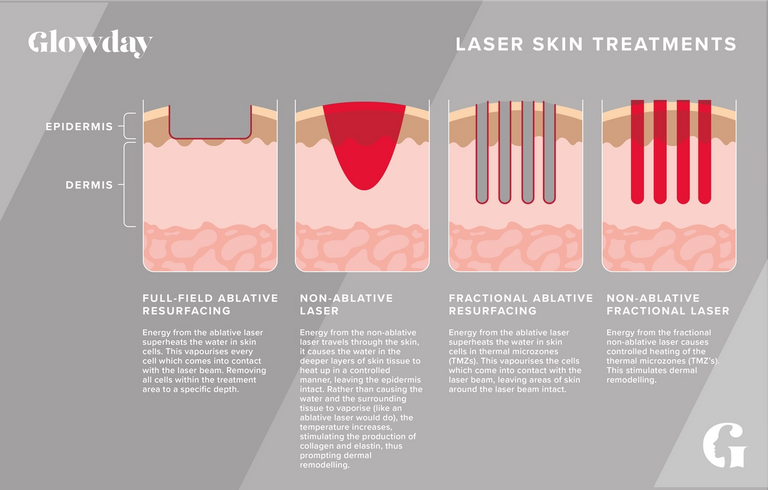Non-ablative Laser Resurfacing
Top Questions
Non-ablative Laser Resurfacing Overview
In the last 20 years, there have been significant advances in the field of lasers and their use in aesthetic treatments. This means that lasers are now able to very specifically treat a myriad of skin complaints, and a wide range of skin tones, with far fewer risks and complications.
Non-ablative treatments include: Frax1550, Fraxel® Re:Store and 3JUVE® Rebright.
Non-ablative fractional lasers treat fine lines and wrinkles, sun damaged skin, acne scarred skin and those with enlarged pores and uneven skin texture. They can also be used to improve skin texture and tone, improving the appearance of age spots and other pigmentation issues. Non-ablative fractional lasers are much gentler than their ablative counterparts, requiring virtually no downtime.
Following a treatment, the skin is not visibly affected, other than some mild redness or swelling. This does, however, mean that more treatments are needed for optimal results.
Non-ablative laser treatments are best if you are relatively young, have mild to moderate skin ageing and are happy to have, and can finance, multiple treatments.
This treatment guide has been verified and edited by Dr Sophie Shotter.
How does non-ablative laser resurfacing work?
Most non-ablative lasers are fractional non-ablative lasers.
These lasers create microchannels (called Microscopic Thermal Zones or MTZs) of damage within the skin.
As the laser travels through the skin, it causes the water in the deeper, dermal layers of skin to heat up. They do this in a controlled manner, so rather than causing the water and the surrounding tissue to vaporise (like an ablative laser would do), the temperature increases, tightening existing collagen whilst also stimulating the production of collagen and elastin, thus stimulating dermal remodelling.
Most non-ablative lasers are fractional non-ablative lasers. These create microchannels (called Microscopic Thermal Zones or MTZs) of damage within the skin. As the laser travels through the skin, it causes the water in the deeper, dermal layers of skin to heat up. They do this in a controlled manner, so rather than causing the water and the surrounding tissue to vaporise (like an ablative laser would do), the temperature increases, tightening existing collagen whilst also stimulating the production of collagen and elastin, thus prompting dermal remodelling.
The channels are surrounded by healthy and intact skin, which means that non-ablative laser skin treatments are far less invasive than ablative laser skin treatments. They also leave the epidermis completely intact, making them a great alternative to more invasive laser treatments. They still produce a skin rejuvenating effect, albeit to a more moderate degree than their ablative counterparts (see diagram). The upside is that risk of complications is much reduced.

What is non-ablative laser resurfacing used for?
Non-ablative laser treatments are best for younger people who have mild or moderate skin age concerns.
Typical concerns include:
- Fine lines and moderate wrinkles
- Signs of sun damage
- Acne scarring
- Uneven skin texture
- Enlarged pores
- Skin pigmentation
- Age spots
Non-ablative laser resurfacing may not be suitable if you have:
- A history of keloid scarring
- An active herpes infection
- Impetigo
- Active acne
- A dark tan or black skin (NB: There are certain brands of laser machine which are suitable for dark skin tones, speak to your practitioner for more information)
- Used isotretinoin in the last year
- Diabetes mellitus
- Smokers
How should I prepare for non-ablative laser resurfacing?
Your practitioner may ask you to prepare for your treatment by:
6-8 weeks prior to your treatment you should avoid sun exposure and false tanning products.
4 weeks prior to your treatment, to prepare your skin and to kick start the production of collagen, your practitioner may recommend you use a topical retinoid product alongside exfoliating acids, such as alpha-hydroxy acid based creams.
2 weeks prior to your treatment, your practitioner may prescribe an anti-viral medicine (like Acyclovir) if you are prone to coldsores.
1 week prior to your treatment you should:
- Stop taking asprin, NSAIDs and Vitamin E supplements
- Have a patch test
NB: Before and after your non-ablative laser treatment you need to avoid sun exposure. Ideally, you will avoid the sun for at least 2 months prior to your treatment. Equally, to get the best out of your laser treatment, you should avoid sun exposure following your treatment. Investing in, and using, a broad spectrum SPF 50 product everyday is advised.
What happens during a non-ablative laser resurfacing treatment?
Step One - Step One - The Consultation and Consent
On arrival at the clinic, your practitioner will complete a detailed personal and medical history form with you.
They will discuss your medical history and clearly highlight the realistic, expected result of the treatment.
Step Two - Step Two - Your non-ablative laser resurfacing treatment
Your Treatment will take around 15-90 minutes, depending on the machine being used and size of the area to be treated.
Your Practitioner will protect your eyes and numb your skin with a topical anaesthetic cream one hour before your treatment.
Step Three - Step Three - The Check-up
It is good practice for your Practitioner to offer a free check-up, a few days to two weeks after your treatment. This allows them to check that the treatment was appropriate for the agreed outcome and to answer any questions you may have.
Step Four - Step Four - The Repeat Treatment
Depending on the issue you were having treated, you may be advised to have additional treatments, 4-6 weeks from your original treatment. Your practitioner will advise regarding when you may require a repeat treatment.
What happens after a non-ablative laser resurfacing treatment?
Immediately after your treatment, your skin will appear red and feel warm, similar to a mild sunburn. This should dissipate within 24 hours, although, don’t be worried if it persists for a couple of days.
Do not undertake any strenuous exercise. Avoid hot showers and baths and do not expose your skin to any sun. You need to try to keep your skin cool.
You may experience dry skin. In rare cases, acne may flare up, particularly in younger people.
If you are susceptible to cold sores, you may have a breakout following non-ablative laser treatments. It may be an idea to keep lysine supplements and acyclovir medication to hand following your treatment.
What are the side effects and risks of non-ablative laser resurfacing?
The risk of side effects is low.
Possible side effects include short-term redness, potential blistering and temporary darkening of the skin in rare cases.
How much does non-ablative laser resurfacing cost?
Costs for non-ablative laser treatments vary depending on the size of the treatment area and the brand of laser used.
Expect to pay anywhere from £200 to £600 for a single treatment and £2000 to £3000 for a full face.
Glowday Disclaimer
All information in our Glowday Treatment Guides and blog articles is intended for reference and information. The information given here is to help you make informed decisions when considering the wide range of non-surgical aesthetic treatments available.
It is NOT intended as medical advice. Any reliance placed by you on the information contained within the Glowday Treatment Guides, Glowday blog articles or on any of Glowday.com is done by you at your own risk.
Before undergoing any non-surgical cosmetic treatment mentioned anywhere on Glowday.com, you should fully consult with an appropriately qualified and accredited practitioner who is properly trained in and fully insured to conduct the treatment you are interested in. Neither the author of the guides or blog articles, or the practitioner who has verified the guides nor Glowery Limited can be held responsible or liable for any loss or claim arising from the use or misuse of the content of Glowday.com.

